That independent, noncorporate, grassroots outburst of countercultural participatory journalism is finally beginning to generate modern-day notice.
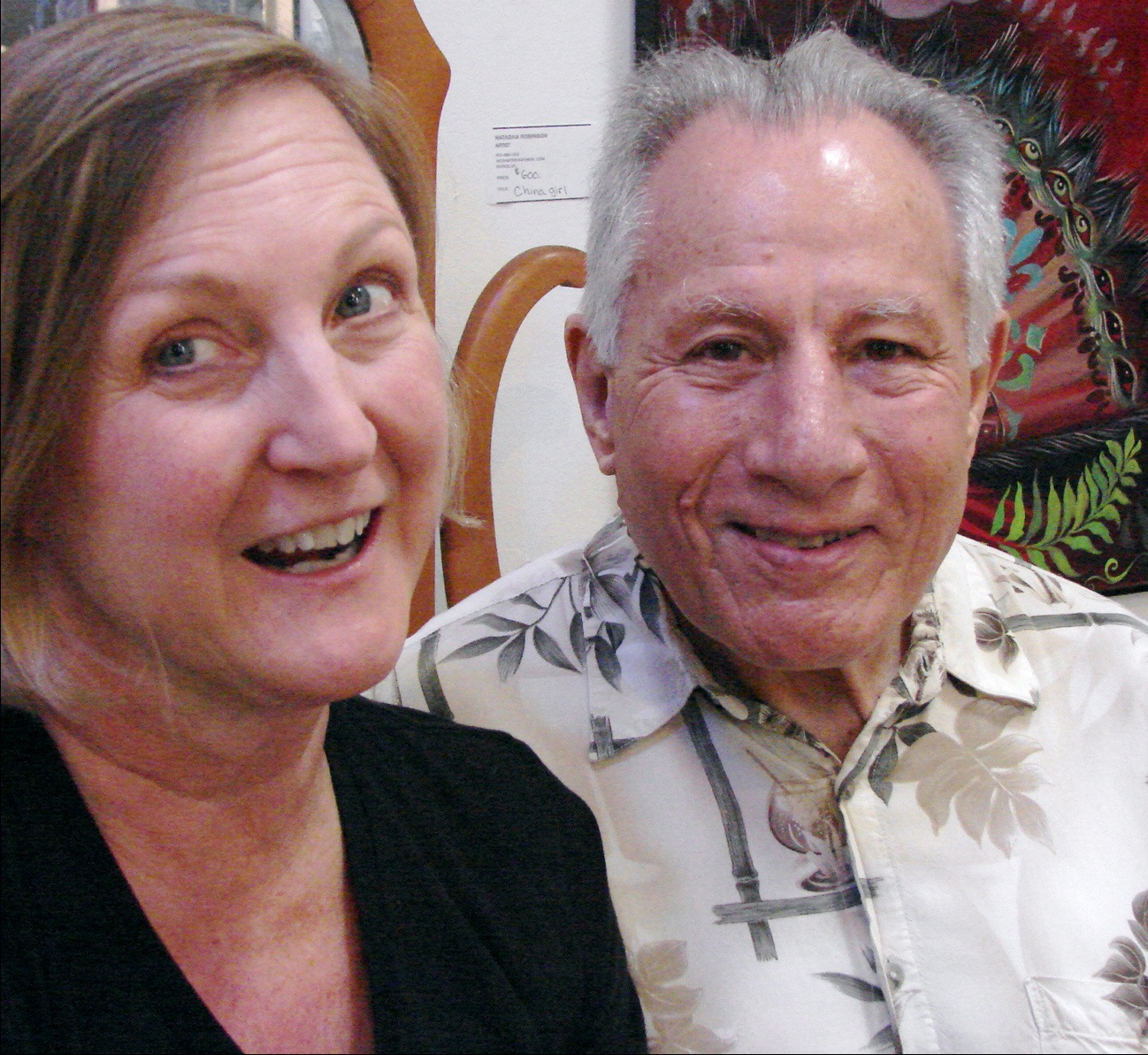
Eugene Schoenfeld aka “Dr. HIPpocrates,” author of the infamous sexuality and health column, “Dr. Hip,” with Barb 50th anniversary organizer Diana Stephens. Photo by John Jekabson, former Barb managing editor.
[This is the first of a three-part series written for The Rag Blog by underground press historian Ken Wachsberger.]
It’s fiftieth anniversary season for the countercultural underground press class of 1965 — time to celebrate because that was the year the East Village Other, the Berkeley Barb, The Paper, and the Fifth Estate appeared for the first time.
The next year, those four papers and the Los Angeles Free Press — founded in 1964 by Art Kunkin with inspiration from the recently invented offset printing process — together formed the Underground Press Syndicate (UPS), the first nationwide network of countercultural underground papers from this country, along with two British pacifist publications, Peace News and Sanity.
And then the underground press exploded.
‘Turning 50 is a really big deal and there’s a lot of activity and interest right now.’
To Rag Blog editor Thorne Dreyer, himself a veteran of Austin’s The Rag (from the class of ‘66, along with the San Francisco Oracle and the Illustrated Paper, the next members to join UPS), “turning 50 is a really big deal and there’s a lot of activity and interest right now.”
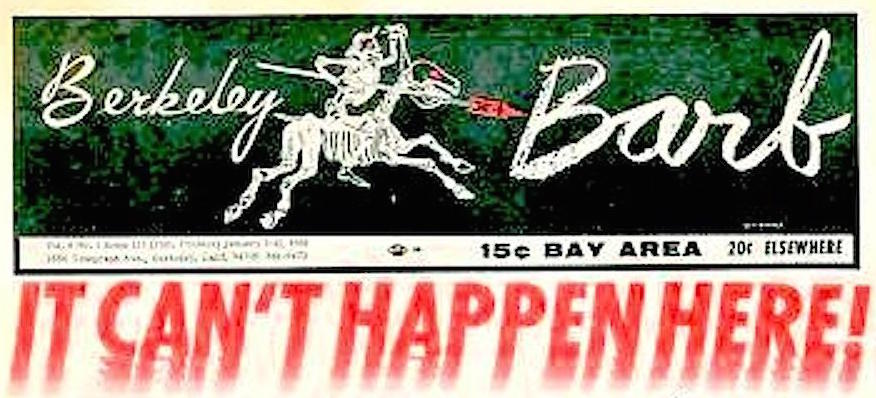
But it did! Image from alumni.berkeley.edu.
Indeed, the countercultural underground press of the Civil Rights and Vietnam eras — that independent, noncorporate, grassroots outburst of participatory antiwar journalism and poetry; community activism; left-wing and anarchist advocacy; investigative and literary brilliance; spiritual mystery; profound apostasy; and visuals that have never been equaled — is finally beginning to generate modern-day notice:
- Historians and journalists are writing books and articles about it.
- The first two members of ‘65 have held their reunions: the Berkeley Barb and Detroit’s Fifth Estate.
- The Rag, the print predecessor to today’s Rag Blog and Rag Radio, is reporting its rebirth amidst plans for an anniversary celebration late next year that will include public events and exhibits, a book, and the premiere of a documentary film about the paper’s historical role.
- Signs are stirring that the Chicago Seed, founded in 1967, may do the same.
- Former staff members of the East Village Other, not waiting for the fiftieth anniversary, opened on February 28, 2012, a major EVO exhibition at New York University’s Arthur L. Carter Journalism Institute called “Blowing Minds: The East Village Other, the Rise of Underground Comix and the Alternative Press, 1965-1975.“
- And the largest effort ever to digitize underground, alternative, and literary newspapers and magazines from the fifties through the eighties is under way.
It’s a big deal to me, too, having been writing about and researching the underground press since soon after I stopped writing for it and having been part of the digital project since its inception five years ago. So I was fortunate to attend the first two reunions, for the Barb and the Fifth Estate. They were both joyous occasions as well as, in the best tradition of the sixties, educational, activist, and reflective celebrations of art, music, film, and writing.
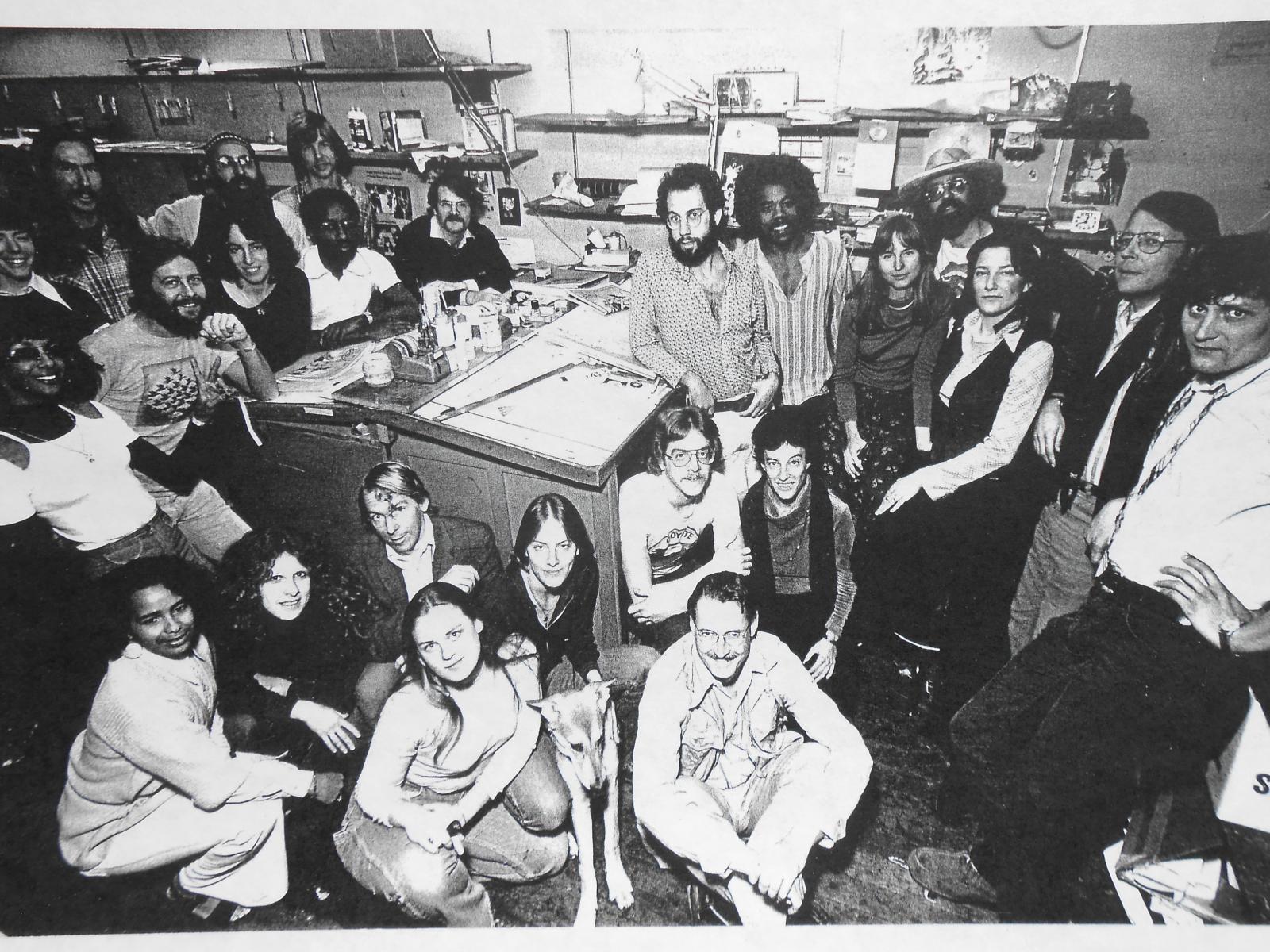
In the day: The Berkeley Barb staff. Photo by Dave Patrick. Image from alumni.berkeley.edu.
Berkeley Barb:
Time mellowed resentment’s jagged edges
The Berkeley Barb was founded by Max Scherr, a passionate but tight-fisted countercultural radical. It was known for its hard-hitting coverage of local and international news, especially in the antiwar, countercultural community; its outrageous visuals; its support of the minority and gender liberation movements; and its sex ads. In 1969, a significant number of rebellious staff members revolted against what they believed to be unfair pay and regrouped as Barb on Strike, which later became the Berkeley Tribe.
For anyone looking for an event to resolve any lingering political and economic divisions from that break, this wasn’t it. None was evident. In fact, key members of the reunion committee were also key players in the split. At this fiftieth anniversary, any remaining hostility was, from what I could see, put aside.
And yet the issues that inspired that hostility were not ignored. The Barb’s celebration was held from Sunday to Friday, August 9-14. At Thursday’s all-day conference, in the morning panel moderated by Judy Gumbo, herself a member of the reunion committee and a leader of the split, the five panelists represented all eras of the Barb’s 15-year history, from its founding in 1965 to its closing down in 1980. Judy asked each panelist two personally relevant questions. Those who were around for the split were asked their views on it.
Michael Carmen told a funny story about how he sold the paper’s first sex ad to a foot fetishist.
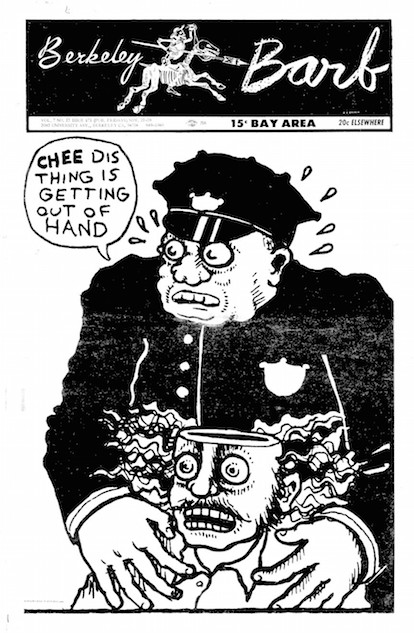 Michael Carmen, the Barb’s first advertising manager, told a funny story about how he came to sell the paper’s first sex ad, to a foot fetishist whose ads successfully moved his fetish a step forward. John Jekabson, a staff member from 1966 to 1969, recalled fond thoughts of his mentorship with Barb founder Max Scherr, and how difficult it was for him later to become part of the Berkeley Tribe rebellion.
Michael Carmen, the Barb’s first advertising manager, told a funny story about how he came to sell the paper’s first sex ad, to a foot fetishist whose ads successfully moved his fetish a step forward. John Jekabson, a staff member from 1966 to 1969, recalled fond thoughts of his mentorship with Barb founder Max Scherr, and how difficult it was for him later to become part of the Berkeley Tribe rebellion.
Leo Laurence told his story about getting fired at radio station KGO for being gay and later being brought to the Barb by Gar Smith. He became visibly emotional and then cried in gratitude at the opportunity the Barb had given him, and also for the strong support and protection he received from the Black Panthers, who were strong supporters of gay rights.
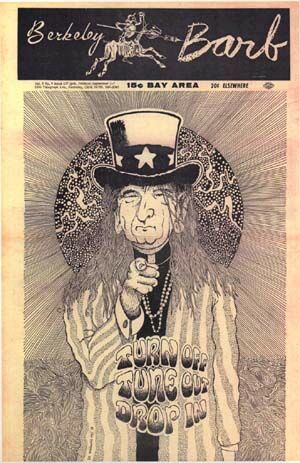 Kathy Streem laughed along with the audience as she shared her story about coordinating sex ads as successor to Judy Gumbo, and getting fired in 1976 for becoming friends with the women who she met from the sex industry. Gregg Pascal Zachary recalled being with the Barb at the end and later working for Liberation News Service (LNS), the AP-UPI of the underground press, and The Spectator in Bloomington, Indiana.
Kathy Streem laughed along with the audience as she shared her story about coordinating sex ads as successor to Judy Gumbo, and getting fired in 1976 for becoming friends with the women who she met from the sex industry. Gregg Pascal Zachary recalled being with the Barb at the end and later working for Liberation News Service (LNS), the AP-UPI of the underground press, and The Spectator in Bloomington, Indiana.
The idea for the panel was good and participants’ answers kept the attention of the crowd. Having a chronology from early staff members to late, covering the entire span of the Barb, was an original and successful idea.
Scherr’s penny-pinching personality and the role of the sex ads were called out multiple times. Both issues were discussed analytically and anecdotally, with an air of retrospective amusement.
What stood out was the love that the panelists
all felt for the paper.
What stood out was the love that the panelists all felt for the paper and the pride they felt at the respective role each had played in its success. Clearly, time mellowed resentment’s jagged edges.
As Judy noted, “Max was a miser and a sexist and things were difficult for the Barb, but it is time for us to forgive the sins of the past. The Barb played an important role in opening up Berkeley, the Bay Area, and the country to every issue that confronts us today.”
In her opening keynote address, Trina Robbins gave an overview of her career as a groundbreaking feminist comix artist and historian, including with It Aint Me Babe, the first feminist underground newspaper in this country. Feminist poet Alta, also a veteran of It Aint Me Babe as well as the publisher of Shameless Hussy Press, kicked off the afternoon proceedings with a reading.
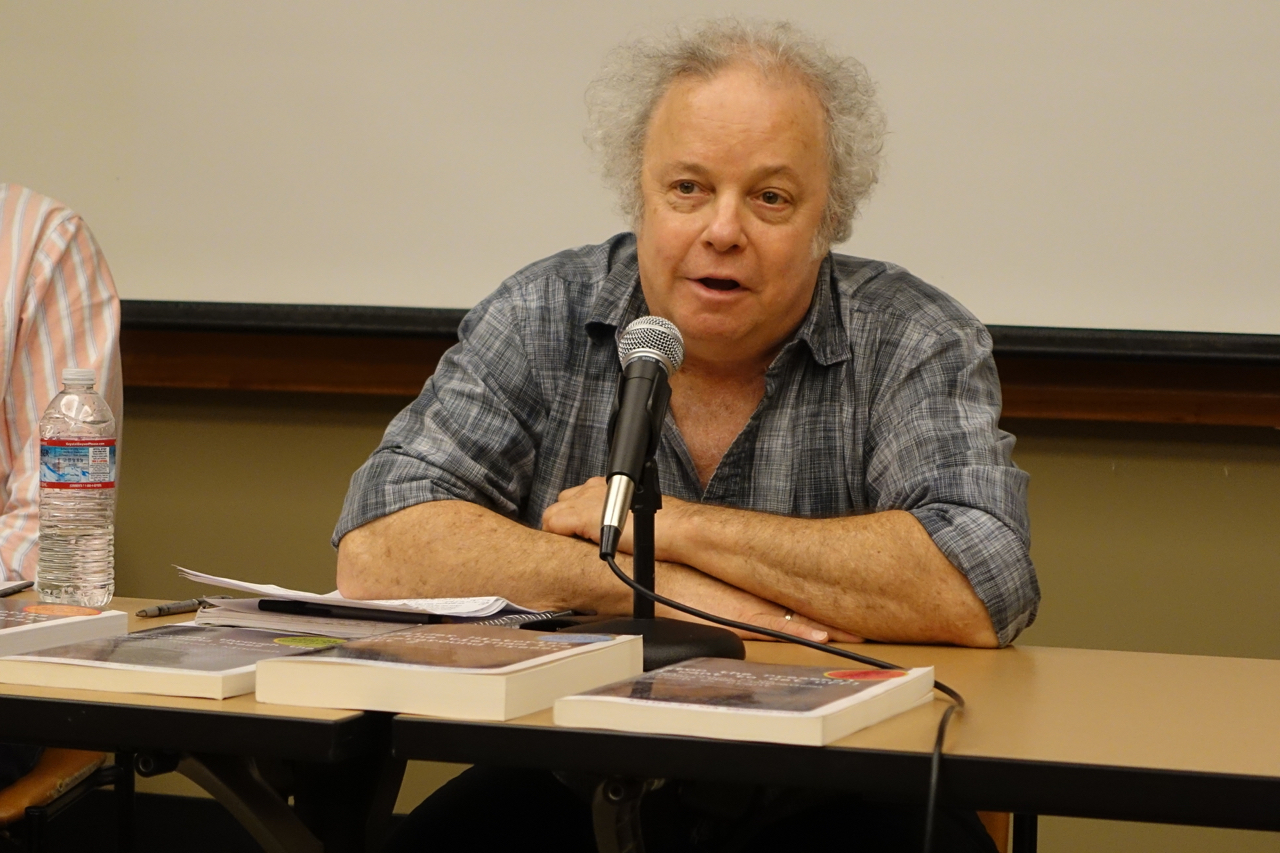
The author, Ken Wachsberger, speaks on a panel at the Berkeley Barb reunion. Photo by former Barb staffer Jayson Wechter.
I was honored to share the afternoon panel with Peter Richardson, historian of Ramparts magazine and the Grateful Dead; and Seth Rosenfeld, chronicler of the FBI-Ronald Reagan war against student radicals in the sixties. Diana Stephens — who was moved to organize the reunion as a result of writing her master’s thesis on the rise of radical feminism inspired by the radical press’s increasingly sexist content, which relied heavily on the Barb as a primary source — moderated this panel.
‘Dr. HIPpocrates’ described the period as
‘the golden age of sex.’
In the conference’s concluding keynote address, Dr. Eugene Schoenfeld, whose sex advice column in the Barb was reprinted for free in UPS-member underground papers all over the country, including the Fifth Estate, as “Dr. HIPpocrates,” described the period as “the golden age of sex,” after discovery of the pill and before AIDS.
Unfortunately, I was unable to attend the two outlying events: an exhibit of photos by Harold Adler and of erotic and other art by Barb illustrator Patricia Oberhaus at the Art House on Sunday, and a film festival that played to a full house at the East Bay Media Center on Friday. But, as an invited speaker, I was a guest at the staff reunion on Wednesday night at Freight & Salvage.
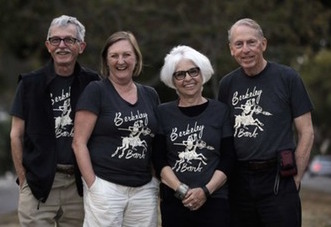
From left: John Jekabson, Diana Stephens, Judy Gumbo, and Gar Smith. Image from yippiegirl.com.
There, along with 150 others and surrounded by food, drink, and memorabilia from the period, I met or was reunited with Dr. HIP, former Black Panther Bobby Seale, friends I first met in Miami Beach in 1972 outside the two presidential nominating conventions, veterans of the Berkeley Free Speech Movement, and former staffers at other underground newspapers including Joint Issue from Lansing, Michigan, my home base during the war, and a member of Underground Press Syndicate.
The live concert closed with Country Joe McDonald, who talked more than he sang.
The live concert, which was free to the public, opened with Sal Valentino, former singer with the Beau Brummels, and closed with Country Joe McDonald, who talked more than he sang — upsetting no one because he is a masterful storyteller. His final story was about how he came to begin his “Fixin’ to Die Rag” with the chant made famous by the Woodstock video: “Give me an F….” Of course, he then sang it, with appreciative audience participation.
Diana Stephens, the inspiration and driving force behind the reunion, lists off lessons that they learned in making it a success:
Book the talent as far in advance as possible. Have one person in charge of fundraising. Design and plan a historical display for the community to enjoy. Keep the tone cooperative and positive. The sixties were a fractious time and it is tempting for some people to fall into old patterns of thinking and behaving. This type of event must be inclusive. The really cranky folk tend to weed themselves out. You will not please everyone; that’s to be expected.
I was afraid we would lose an important opportunity to recognize the contributions made by the Barb if we didn’t have a reunion. Max told Gar he was concerned he would disappear down the “memory hole,” but this was bigger than any one man.
The Movement is being portrayed rather negatively in our collective history. The sixties and especially the seventies were dangerous times, but what we have reaped from those experiences has been overwhelmingly positive. I am hoping to continue collecting voices from that era as videotaped interviews and memoirs are a great resource for historians. The website, with its link to the Berkeley Barb archive, is our best contribution to date.
[In Part II, Ken goes to a reunion of Detroit’s Fifth Estate and discusses that paper’s storied — and continuing — history.]
Find articles by and about Ken Wachsberger on The Rag Blog.
[Ken Wachsberger is a long-time writer, editor, political activist, and member of the National Writers Union. He is the editor of the four-volume Voices from the Underground Series and a driving force behind Independent Voices, Reveal Digital’s underground press digital project.]


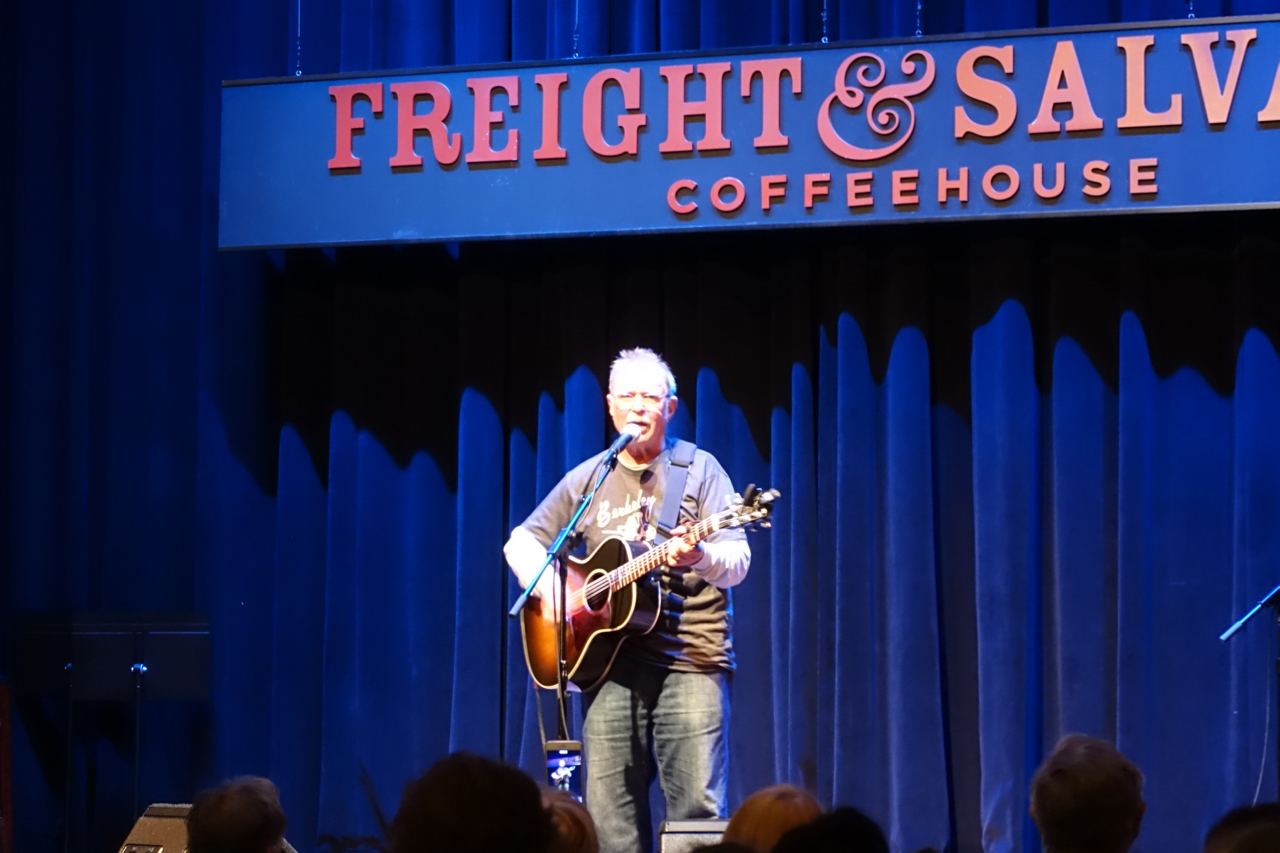

















I loved it! Can’t wait to share it. Thanks so much.
How we would have loved to attend this reunion! We would have, if Wilson could speak, and if I could walk. I am writing for the two of us, due to Wilson’s Traumatic Brain Injury. Originally, last year, I had been optimistic, agreeing to attend. But by the time the event rolled around I knew Wilson was too frail to handle being in a crowd, and navigating our orthopedic devices on our own became a laughable notion. Wilson’s brain injury has left him confused and uncomfortable in large groups, even though he loves the attention for a little while. Just know that we appreciated being of what little help we could offer, with archival material, and that our hearts were with you all. Personally, I would have been thrilled to meet some of these courageous people from those fearless years. Thank you, Ken, for writing this.
11/28/2015 Thorne, The Rag Blog and Ken,
Thanks for sharing Ken’s musing on the 50th Anniversary of the arrival of the “Underground” press as a wonderful flashback to a different time here in America that inspired many Underground/Alternative newspapers to roll off a photo off set web feed press for several years later, as an after birth of those mentioned above. In Dallas, on the S.M.U. campus, March 17, 1967, Notes From the Underground published anonymously and arrived hot off a Xerox machine at an I.B.M. building on Lemon Avenue, and was picked up so quickly by students, that a second run of the first issue was photo copied again, thanks to I.B.M. From this several papers bannered up above the fold: Dallas Notes, Dallas News, Iconoclast, Hooka Notes, in Austin for a short press run L.S.D.–Lone Star Dispatch, Fort Worth’s Outlaw Times, and others faded into the fog of my mind. Perhaps, Dallas should do a celebration of its own, that then were on a roll.
Hey, Doug. At least you should plan to attend the Rag Reunion and public celebration (of our 50th birthday), set for the weekend of Oct. 14, 2016, in Austin. At our last gathering, in 2005, there was essentially a sub-reunion of folks from Space City! in Houston.
Thanks to all for your kind words. Being invited to speak at the reunion was a supreme honor. Diana was one of the key organizers and, indeed, the inspirational force behind having the reunion in the first place. Lorraine and Wilson, I’m sorry I didn’t get to meet you both. Doug, thanks to your efforts most of the Dallas-area underground press will be preserved in the underground press digital collection that I spoke about in my talk. https://goo.gl/1oCkk3 I’m grateful to Rag Blog for giving me the opportunity to share my thoughts. Don’t miss part 2 of this three-part adventure, already out, about the Fifth Estate’s 50th anniversary reunion, and part 3, upcoming, an overview of the underground press.
Any idea how I can contact Dave Patrick, an old friend, who worked for my short-lived paper, The Berkeley News, just before moving to the Barb.